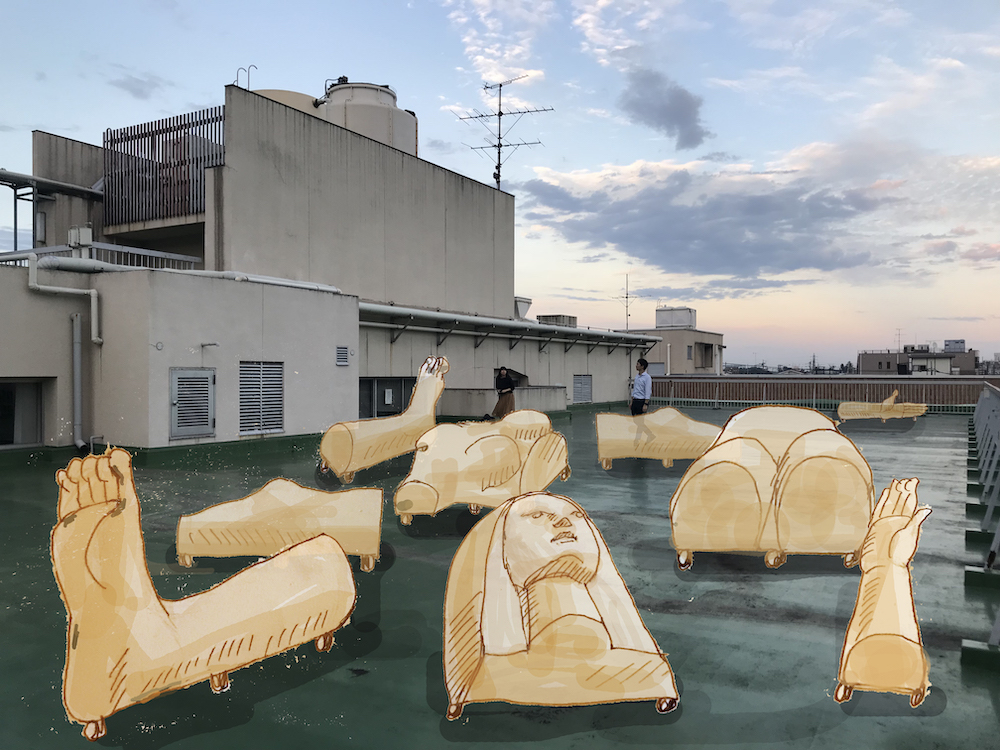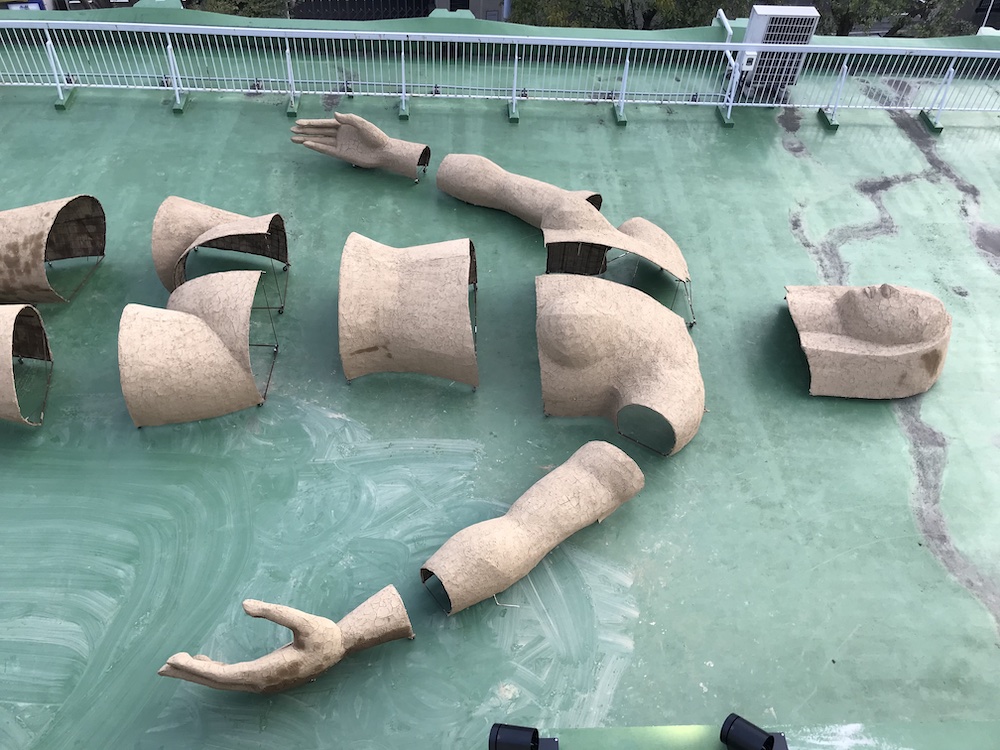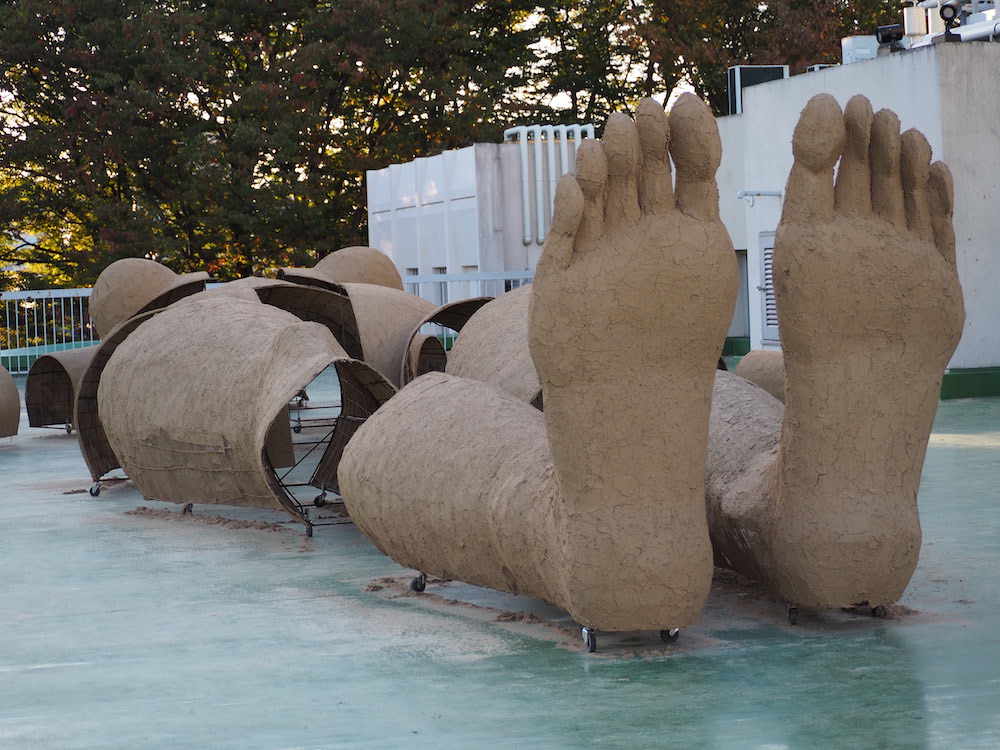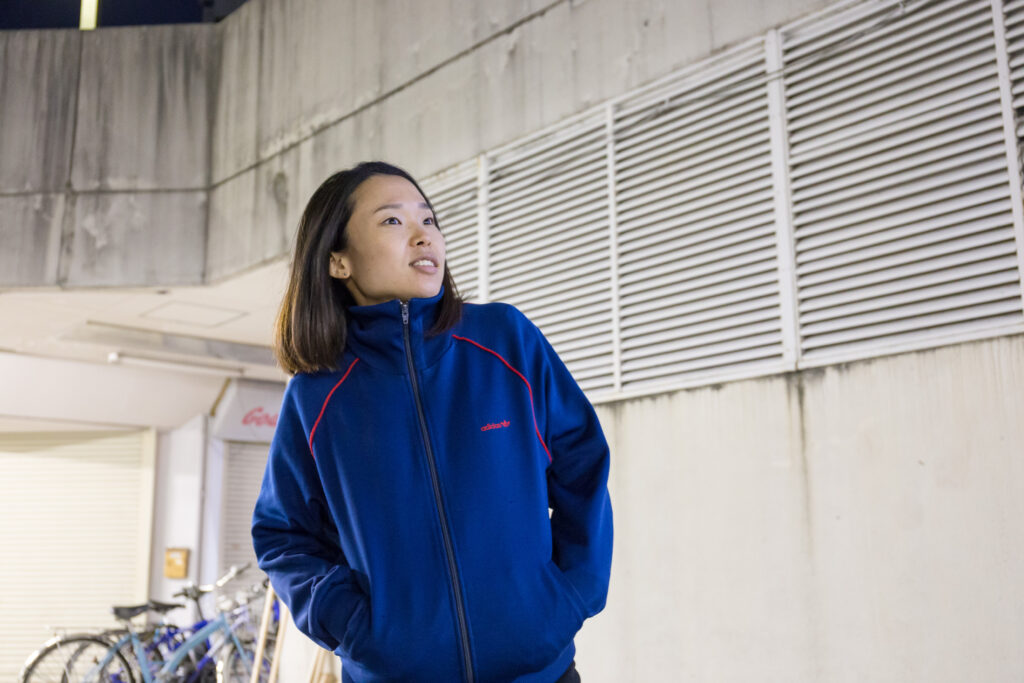ハイヌウェレの彫像
Statue of Hainuwele
10:00-18:00
※13日(土)
公開制作は13日(土)のみとさせていただきます
横浜トリエンナーレ組織委員会

象の鼻テラスでは、横浜トリエンナーレ組織委員会と連携した屋外アート展示企画で、久保寛子の「ハイヌウェレの彫像」(2020年)をご紹介します。
アーティストステートメント
ハイヌウェレとはインドネシアの神話に登場する女神で、殺されたその体から食物が生まれたとされます。
日本神話におけるオオゲツヒメの逸話のように、同型の神話が世界各地に点在することから、民俗学者のアドルフ・イエンゼンがそれらをまとめて“ハイヌウェレ型神話”と名付けました。
この作品を構想していた2020年、世界は新型ウイルスの脅威に晒され始め、私はこの社会や人類の未来に不安を感じるようになりました。
その不安は自身の関心をより根源的、原始的なものへ向けさせ、世界の古代神話や縄文土器/土偶をはじめとした日本の考古学に創作のヒントを求めました。
作品の表面に使用している“土”は人間の創作活動において最も古い素材の一つであり、世界や人間の始まりを“泥”や“粘土”として表現する神話も多く存在します。
異常気象による土砂災害や河川氾濫などの水害が多発している現代においても、“土”は我々に色々なイメージを喚起させる物質と感じます。
仰向けに寝そべる断片化された女性像は、雨や日光や風の影響を受けて時間とともに変化します。
作品が作る空間や土の表情を身体で体感していただけたら幸いです。



関連イベント
本作品は表面を土で塗り固め、表情を生み出しています。
土塗り作業を一緒にする参加者を募集します。
開催日時:2024年4月13日(土)14:00-16:00
会場:象の鼻パーク
参加費:無料
定員:20名
対象:子ども〜大人までどなたでも
参加方法:要予約(定員に達しない場合は当日受付も可)
event(a)zounohana.comまでお名前と連絡先を添えてご連絡ください。
※(a)を@に変更して送信してください。
※件名に、「4月13日 作品制作体験予約申し込み」とご記入ください。
※先着順に受付します。
※汚れてもいい服装でご参加ください。
久保寛子×平藤喜久子
神話、信仰といった土着的なモチーフを作品に投影している久保寛子が、神話学を専門とする平藤喜久子との対談により、自身の作品を深く掘り下げます。
登壇:久保寛子、平藤喜久子(國學院大學教授)
開催日時:2024年4月29日(月・祝)15:00-16:30(14:30開場)
会場:象の鼻テラス
参加費:無料
参加方法:予約不要、直接会場にお越しください。


Statue of Hainuwele
Artist: Hiroko Kubo
Zou-no-hana Terrace will host Hiroko Kubo’s “Statue of Hainuwere” (2020), an outdoor art exhibition in collaboration with the Organizing Committee for Yokohama Triennale.
Outline
Dates: April 13 Sat.‒ 29 Mon. 2024, 10:00-18:00
*Live sculpting: 13 Sat. and 14 Sun.
Venue: Zou-no-hana Park
Organizer: Zou-no-hana Terrace, Committee for Yokohama Triennale
Artist Statement
Hainuwele is a mythological goddess in Indonesian folklore, and it is said that food was produced from her slain body. Similar myths exist worldwide, with one example being the anecdote of Ogetsuhime in Japanese mythology. The folklorist Adolf Jensen collectively named these myths as “Hainuwele-type myths.” As I was planning this work, the world began facing the threat of a new virus, causing anxiety about the future of society and humanity. This anxiety shifted my focus towards more fundamental and primal subjects, leading me to seek inspiration in the ancient myths and the archaeology of Japan, particularly Jomon pottery and gurines. The “soil” used on the surface of the artwork is among the oldest materials in human creative endeavors, with numerous myths depicting the genesis of the world and humanity in terms of “mud” and “clay.” In today’s age, marked by frequent landslides and ooding due to abnormal weather conditions, the concept of “soil” still evokes a wide array of images for us. The fragmented female gure, reclining on its back, will change over time, in uenced by rain, sunlight, and wind. I hope you can personally experience the space and texture of the soil created by the artwork with your own body.
Artist Profile
Born in Hiroshima, Japan in 1987, Kubo received her MFA from Texas Christian University in 2013. Based on her research of prehistoric art, ethnic art, and cultural anthropological theories, she uses everyday materials to create sculpture works. Recent major exhibitions include “GO FOR KOGEI” (Kansui Park, Toyama, Japan, 2023), “Takamatsu Contemporary Art Annual vol.10: There Is No Boundaries Here./?” (Takamatsu City Museum of Art, Kagawa, Japan, 2022) and “The Romantic Route 3 Art Festival” (Miaoli, Taiwan, 2023). Her large works are in the collections of KAMU KANAZAWA (Ishikawa, Japan), Chishima Foundation for Creative Osaka (Osaka, Japan) and others. Future exhibit is “Steel framed Goddess”, Pola Museum Annex, April 26-June 9.

